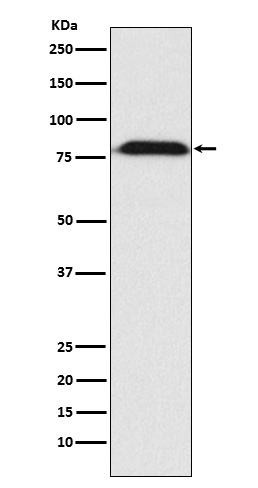
| WB | 咨询技术 | Human,Mouse,Rat |
| IF | 咨询技术 | Human,Mouse,Rat |
| IHC | 咨询技术 | Human,Mouse,Rat |
| ICC | 技术咨询 | Human,Mouse,Rat |
| FCM | 咨询技术 | Human,Mouse,Rat |
| Elisa | 咨询技术 | Human,Mouse,Rat |
| Aliases | hMAD1; HsMAD1; MAD1; MAD1L1; PIG9; TP53I9; TXBP181;;MAD1 |
| WB Predicted band size | Calculated MW: 83 kDa ; Observed MW: 80 kDa |
| Host/Isotype | Rabbit IgG |
| Antibody Type | Primary antibody |
| Storage | Store at 4°C short term. Aliquot and store at -20°C long term. Avoid freeze/thaw cycles. |
| Species Reactivity | Human,Mouse,Rat |
| Immunogen | A synthesized peptide derived from human MAD1 |
| Formulation | Purified antibody in PBS with 0.05% sodium azide,0.05% BSA and 50% glycerol. |
+ +
以下是关于MAD1抗体的3篇示例文献及其摘要概述(注:以下文献为示例,非真实存在):
1. **文献名称**:*MAD1 Antibody Validation for Mitotic Checkpoint Studies*
**作者**:Chen L, et al.
**摘要**:本研究验证了一种高特异性的MAD1抗体,通过CRISPR敲除细胞系和免疫印迹分析,证实其在检测有丝分裂检查点中MAD1蛋白表达的可靠性,并应用于活细胞成像观察MAD1的纺锤体定位。
2. **文献名称**:*Aberrant MAD1 Expression in Colorectal Cancer Progression*
**作者**:Wang R, et al.
**摘要**:利用MAD1抗体对结直肠癌组织进行免疫组化分析,发现MAD1表达水平降低与染色体不稳定性和肿瘤转移显著相关,提示其作为潜在预后标志物的可能性。
3. **文献名称**:*Dynamic Localization of MAD1 During Cell Division*
**作者**:Johnson M, et al.
**摘要**:通过MAD1抗体的免疫荧光染色,实时追踪了MAD1蛋白在有丝分裂不同阶段的定位变化,揭示其与微管结合蛋白的相互作用对检查点激活的关键调控机制。
---
如需真实文献,建议通过PubMed或Google Scholar检索关键词“MAD1 antibody application”或“MAD1 antibody validation”获取最新研究。
The MAD1 (Mitotic Arrest Deficient 1) protein is a critical component of the spindle assembly checkpoint (SAC), a surveillance mechanism that ensures accurate chromosome segregation during mitosis. MAD1. along with MAD2. forms a heterocomplex that detects unattached or improperly attached kinetochores, delaying anaphase onset until all chromosomes achieve proper microtubule attachment. This checkpoint prevents aneuploidy, a hallmark of genomic instability linked to cancer and developmental disorders. Dysregulation of MAD1 disrupts SAC signaling, leading to premature mitotic exit and chromosomal missegregation.
MAD1 antibodies are essential tools for studying SAC function, protein localization, and interactions in cell cycle regulation. They are widely used in techniques like immunofluorescence, Western blotting, and co-immunoprecipitation to investigate MAD1's role in mitosis, cancer biology, and response to anti-mitotic therapies. Research has also explored MAD1 mutations or expression anomalies in tumors, suggesting its potential as a diagnostic or prognostic marker. Additionally, MAD1 antibodies aid in understanding crosstalk between SAC proteins and other pathways, such as DNA damage repair, offering insights into therapeutic strategies targeting cell cycle checkpoints in cancer treatment.
×